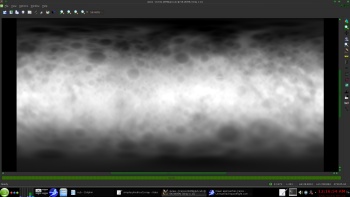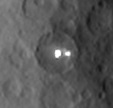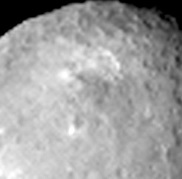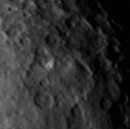Dawn approaches Ceres, From opnav images to first orbit |

  |
Dawn approaches Ceres, From opnav images to first orbit |
 Mar 21 2015, 10:40 PM Mar 21 2015, 10:40 PM
Post
#721
|
|
 Director of Galilean Photography    Group: Members Posts: 896 Joined: 15-July 04 From: Austin, TX Member No.: 93 |
Yes, the descoping that lost Dawn the magnetometer really hurts now. But if it was lose the magnetometer or lose the mission, the choice is easy. Still sucks though.
Radar just wasn't necessary with what we knew of these objects. If we knew now what we knew 10 years ago, of course we'd fly a different mission now. If the white spot is confirmed an active vent, does that place Ceres ahead of Europa and Enceladus now? Ceres has a benign radiation environment and a potentially much shorter cruise with chemical rockets and/or direct destination ion propulsion. I think a Discovery mission at least with magnetometer and higher resolution cameras is feasible, with a separately funded lander. -------------------- Space Enthusiast Richard Hendricks
-- "The engineers, as usual, made a tremendous fuss. Again as usual, they did the job in half the time they had dismissed as being absolutely impossible." --Rescue Party, Arthur C Clarke Mother Nature is the final inspector of all quality. |
|
|
|
 Mar 22 2015, 04:20 AM Mar 22 2015, 04:20 AM
Post
#722
|
|
|
Member    Group: Members Posts: 890 Joined: 18-November 08 Member No.: 4489 |
from my post # 679
the EARLY shape file the highpass image is the top 10% frequency of the image and it is normalized 0-255 those that have not already extracted the data out of the cubesphere plate model ceres_opnav5_512.txt.gz ( cubemapped 512x512 per face of the cube ) i have a isis3 demprep'ed cub Ceres.DEM8ppd.cub.zip 32 bit float in meters of radii ( 0 to 360 long) https://drive.google.com/file/d/0B6ZYAd08tZ...iew?usp=sharing  but remember this is NOT official so ...... |
|
|
|
 Mar 22 2015, 05:11 PM Mar 22 2015, 05:11 PM
Post
#723
|
|
 Member    Group: Members Posts: 656 Joined: 20-April 05 From: League City, Texas Member No.: 285 |
...I think a Discovery mission at least with magnetometer and higher resolution cameras is feasible, with a separately funded lander. How about another ion drive mission, carrying magnetometer plus radar (and of course an optical camera), with nuclear power. Spiral out, stop at Ceres and one or two other asteroids, then on to Europa. Perhaps survey a few Jupiter Trojans on final approach to Jupiter. Perhaps use a VASIMIR drive to cut travel time. |
|
|
|
 Mar 23 2015, 07:14 AM Mar 23 2015, 07:14 AM
Post
#724
|
|
|
Member    Group: Members Posts: 401 Joined: 5-January 07 From: Manchester England Member No.: 1563 |
TBH I think it's public percception and funding that is more an object to such a follow on mission - Ceres will need to turn out to be the Europa of the inner solar system to get such a followup. Of course, it might do yet....
-------------------- |
|
|
|
 Mar 23 2015, 03:09 PM Mar 23 2015, 03:09 PM
Post
#725
|
||
 Senior Member     Group: Moderator Posts: 3233 Joined: 11-February 04 From: Tucson, AZ Member No.: 23 |
Interesting work with the DEM everyone. It made me think about the bright spots again. I remembered that there is a crater on Iapetus, Johun, that has a central ridge, rather than a central peak:
The DEM seems to suggest it, though again how real that is... It would explain why there are two bright spots: rather than having an ice/salt-rich central peak, the two ends of a central ridge would instead be ice/salt-rich. -------------------- &@^^!% Jim! I'm a geologist, not a physicist!
The Gish Bar Times - A Blog all about Jupiter's Moon Io |
|
|
|
||
 Mar 24 2015, 10:29 AM Mar 24 2015, 10:29 AM
Post
#726
|
|
 Junior Member   Group: Members Posts: 24 Joined: 29-May 08 From: Seattle, USA Member No.: 4162 |
The problem with that comparison is that Johun is decidedly oblong, so that the "central ridge" is still indeed central with respect to the crater walls. The images of the bright-spot crater show it to be much more circular; while the brighter of the two spots is central, the dimmer is decidedly closer to the wall. Not saying it couldn't be an offshoot of the main bright spot, but it doesn't appear to be the endpoint of a "central ridge".
We'll see soon. |
|
|
|
 Mar 24 2015, 02:21 PM Mar 24 2015, 02:21 PM
Post
#727
|
|
|
Solar System Cartographer     Group: Members Posts: 10153 Joined: 5-April 05 From: Canada Member No.: 227 |
No need to focus on the shape of that crater, though. Check out King crater on the Moon, circular with a very prominent two-pronged ridge of a central peak. It's the basic concept that is important here.
Phil -------------------- ... because the Solar System ain't gonna map itself.
Also to be found posting similar content on https://mastodon.social/@PhilStooke Maps for download (free PD: https://upload.wikimedia.org/wikipedia/comm...Cartography.pdf NOTE: everything created by me which I post on UMSF is considered to be in the public domain (NOT CC, public domain) |
|
|
|
 Mar 24 2015, 05:42 PM Mar 24 2015, 05:42 PM
Post
#728
|
|
 Member    Group: Members Posts: 495 Joined: 12-February 12 Member No.: 6336 |
On the origin of Ceres, which have been mentioned earlier in a few posts:
The idea that Ceres might originated somewhere else than the current asteroid belt is connected with the Jupiter migration hypothesis. "As the planets migrated, they stirred the contents of the solar system. Objects from as close to the Sun as Mercury, and as far out as Neptune, all collected in the main asteroid belt. Full text from the Harvard-Smithsonian Center for Astrophysics. |
|
|
|
 Mar 24 2015, 08:16 PM Mar 24 2015, 08:16 PM
Post
#729
|
|
|
Member    Group: Members Posts: 890 Joined: 18-November 08 Member No.: 4489 |
that "ridge" in the DEM is 100% pure synesthetic
it is a ARTIFACT from image processing you can see this very easily in the mesh when compared to the image |
|
|
|
 Mar 24 2015, 10:20 PM Mar 24 2015, 10:20 PM
Post
#730
|
||
|
Junior Member   Group: Members Posts: 48 Joined: 20-December 14 Member No.: 7370 |
As for the comparison with the lunar crater, I'd keep in mind that it is clearly resolved while the bright spot on Ceres isn't (it spans less than one pixel). Just speculating here while we wait for more detailed images: We obviously don't know the bright spot size with saturated pixels - but the last dim image looks unsaturated (doesn't max out the pixel intensity - though we have no way of knowing if the image was rebalanced - however since only one pixel was maxed out it doesn't really matter if it was rebalanced or not - all pixels (except possibly one) weren't saturated - though some could still have some bleed effects.). So I would say in this image it almost for sure is bigger than one pixel In any event the smaller spot is clearly not saturated in the dimmest 2 images and only in adjacent 2 pixels in the middle image. The roughly 5x5 pixel size of the smaller white spot would indicate that the brighter spot is most likely even bigger (assuming a similar albedo). A roughly 9x9 pixel bigger white spot crater is consistent with observed images and suggests minimal adjacent pixel bleed over. I have annotated a possible crater that roughly fits my hypothesis and consistent with the moon images I previously showed for comparative analog - it will be fun to see how off base this guess will end up being. White_Spot_Annotated_Crater animated gif - click to animate. |
|
|
|
||
 Mar 25 2015, 06:57 PM Mar 25 2015, 06:57 PM
Post
#731
|
|
 Member    Group: Members Posts: 423 Joined: 13-November 14 From: Norway Member No.: 7310 |
The official word from the framing camera lead investigator, as quoted on the previous page, is that the brightest spot is not resolved (i.e. it is less than one pixel across in the images). How he came to that conclusion, I do not know. I haven't seen any comment on whether or not they think the dimmer spot is resolved.
Regardless of that, there are now less than 3 weeks left for the 49% illuminated 453 pixels OpNav 7 images - that's going to be good (though, I wonder how quickly images of the brightest spots at that resolution will be made available to us..). -------------------- |
|
|
|
 Mar 25 2015, 09:54 PM Mar 25 2015, 09:54 PM
Post
#732
|
|
 Member    Group: Members Posts: 714 Joined: 3-January 08 Member No.: 3995 |
There could be still-unreleased OpNav 4 and OpNav 5 images -- with different lighting circumstances -- that indicate that.
|
|
|
|
 Mar 26 2015, 01:41 AM Mar 26 2015, 01:41 AM
Post
#733
|
||||
 Member    Group: Members Posts: 714 Joined: 3-January 08 Member No.: 3995 |
In anticipation of forthcoming higher-resolution images, I have summarized the various features that Iím eager to see up close. I'm sure I'm not alone....
1. Bright spot pair (obviously  2. Piazzi - Area of bright and dark mottling:  3. Large, flat crater with (possible) broad mounds: 4. Mound (?) in crater:  5. Resurfaced, hummocky region (with fractures?). This includes the large southern crater with a modified rim: I hope to add many more items to the list.... |
|||
|
|
||||
 Apr 6 2015, 08:25 PM Apr 6 2015, 08:25 PM
Post
#734
|
|
 Junior Member   Group: Members Posts: 24 Joined: 29-May 08 From: Seattle, USA Member No.: 4162 |
Excellent summary of "the story so far" at Ceres. The bright spots are the clear winners of the popularity contest, though.
In anticipation of forthcoming higher-resolution images, I have summarized the various features that Iím eager to see up close. I'm sure I'm not alone.... 1. Bright spot pair (obviously  I hope to add many more items to the list.... |
|
|
|
 Apr 10 2015, 07:42 PM Apr 10 2015, 07:42 PM
Post
#735
|
|
|
Senior Member     Group: Members Posts: 2346 Joined: 7-December 12 Member No.: 6780 |
|
|
|
|
  |

|
Lo-Fi Version | Time is now: 29th April 2024 - 10:48 PM |
|
RULES AND GUIDELINES Please read the Forum Rules and Guidelines before posting. IMAGE COPYRIGHT |
OPINIONS AND MODERATION Opinions expressed on UnmannedSpaceflight.com are those of the individual posters and do not necessarily reflect the opinions of UnmannedSpaceflight.com or The Planetary Society. The all-volunteer UnmannedSpaceflight.com moderation team is wholly independent of The Planetary Society. The Planetary Society has no influence over decisions made by the UnmannedSpaceflight.com moderators. |
SUPPORT THE FORUM Unmannedspaceflight.com is funded by the Planetary Society. Please consider supporting our work and many other projects by donating to the Society or becoming a member. |

|